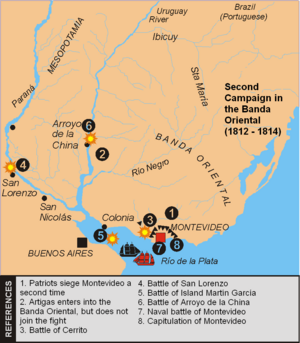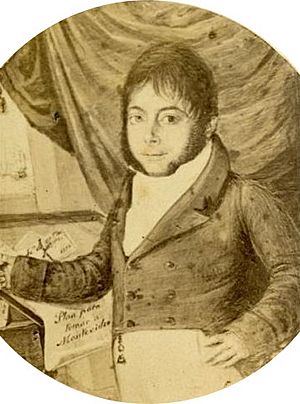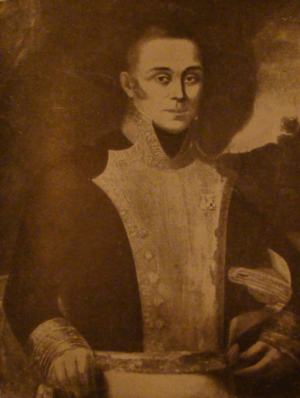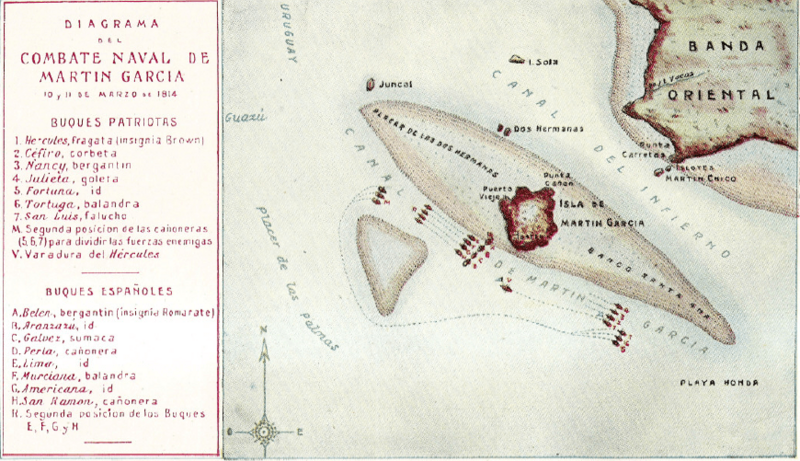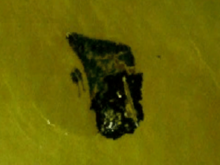Battle of Martín García (1814) facts for kids
The Battle of Martín García was an important fight that happened between March 10 and 15, 1814. It was fought near Martín García Island in the Río de la Plata. On one side were the forces of the United Provinces of South America, led by Lieutenant Colonel William Brown. On the other side were the royalist forces, who supported Spain, led by Captain Jacinto de Romarate.
This battle was a big win for the United Provinces. Even after one of their main ships got stuck, Brown's troops managed to take the island. This victory was very important because it gave the United Provinces control over the rivers that led into the country. It also helped them move closer to Montevideo, a major city. Later, after another big win at the Battle of Buceo, they could completely block Montevideo by sea. This, along with the army blocking the city by land, led to Montevideo surrendering.
Quick facts for kids Battle of Martín García |
|||||||
|---|---|---|---|---|---|---|---|
| Part of the Second Banda Oriental campaign | |||||||
 |
|||||||
|
|||||||
| Belligerents | |||||||
| Commanders and leaders | |||||||
| William Brown | Jacinto de Romarate | ||||||
| Strength | |||||||
| 1 frigate 1 corvette 1 brigantine 2 schooners 1 Falucho 1 sloop [91 cannons] 415 sailors and 177 troops. |
2 brigantines 1 brigantine 1 sloop 3 gunboats 1 landing craft and 4 minor vessels [39 cannons (2 in battery)] 430 troops. |
||||||
| Casualties and losses | |||||||
| One vessel damaged, 23 dead, 35 wounded | One minor vessel captured, 10 dead, 47 prisoners, 17 wounded | ||||||
Contents
Why the Battle Happened
The Fight for Independence
The Battle of Martín García was part of the Argentine War of Independence. This war started on May 25, 1810, when the May Revolution happened in Buenos Aires. People in Buenos Aires decided to remove the Spanish ruler, called a viceroy, and set up their own local government. This new government was known as the Primera Junta.
However, the city of Montevideo, located on the eastern side of the Río de La Plata (an area called the Banda Oriental, which is now Uruguay), did not agree with Buenos Aires. Montevideo decided to stay loyal to Spain. This disagreement led to fighting in the countryside around Montevideo. Soon, Montevideo was surrounded by forces from Buenos Aires and local militias.
Even though Montevideo was surrounded by land, the Spanish navy still controlled the rivers. These rivers included the Río de la Plata, the Uruguay River, and the Paraná River. The Spanish ships from Montevideo were very strong. They even destroyed an early fleet from Buenos Aires at the Battle of San Nicolás. This allowed Montevideo to block the port of Buenos Aires and prevent its capture.
The fighting continued for a long time. In 1812, Montevideo was surrounded again. But the Spanish defenders were tough, and they controlled the rivers. This made it hard for the attackers to win.
Building a New Fleet
By late 1813, the situation for the United Provinces was difficult. Their armies were struggling in other parts of the country. Montevideo still held strong because of its control over the waterways.
A politician named Juan Larrea joined the government in Buenos Aires. He realized that to win, they needed a strong navy. But this was a huge problem! The United Provinces had almost no ships, very few cannons, and lacked important supplies like wood, tar, and rope. They also didn't have many trained sailors or officers. The government also had very little money.
Larrea came up with a clever plan. He made a deal with a rich American merchant named Guillermo Pío White. White agreed to provide the money needed to buy ships and equipment. He would be paid back later if the plan worked.
In just two months, a small fleet was built. Most of the officers and sailors were foreigners, while the soldiers on board were local. There was a big discussion about who should lead this new navy. The main candidates were Benjamin Franklin Seaver, Estanislao Courrande, and Guillermo Brown.
Finally, the command was given to Guillermo Brown, an Irish sailor. He was chosen because he was strong, experienced, and had a great way of leading his crew, many of whom were Irish, British, or Scottish.
Before the Main Battle
Controlling the Island
Martín García Island was very important because it controlled a key channel in the Río de la Plata. This channel was the only way for larger ships to reach the interior rivers like the Paraná and Uruguay. If you controlled the island, you controlled who could sail up these rivers.
In 1813, a small group of revolutionary soldiers briefly took the island from the Spanish. Realizing how important the island was, the Spanish commander Romarate decided to fortify it. He placed cannons on the island and positioned his ships to guard the channel.
The Spanish in Montevideo heard about Buenos Aires building a new fleet. They wanted to attack Buenos Aires before the new fleet was ready. But Brown's fleet was built so quickly that the Spanish plan failed.
Brown, now in command, sailed his new fleet towards Colonia del Sacramento, a town in present-day Uruguay. This was the start of his campaign.
The Battle Begins
The Two Sides
The revolutionary fleet, led by Brown, had seven ships. Their largest ship was a frigate called Hércules. They had 91 cannons and about 600 sailors and soldiers.
The royalist fleet, led by Romarate, had nine ships, mostly smaller ones. They had 36 cannons, with two more on land, and about 440 men.
Even though the revolutionaries had more cannons, a large part of their power was on the Hércules. So, its performance was very important.
Setting the Scene
On March 8, Brown saw three Spanish ships near Colonia. He followed them and realized they were heading to Martín García Island. He then returned to Buenos Aires to get more ships.
That same day, Romarate positioned his ships in a line near Martín García Island. They were supported by two cannons on land and soldiers on the island.
On March 9, Brown's full fleet sailed towards Martín García. By the morning of March 10, they were ready to attack. Brown's plan was to attack the Spanish from both the front and the back. He sent some ships to go around a sandbank to attack from behind, while his main force attacked from the front.
The First Attack
The attack didn't happen exactly as planned. At 1:30 PM, Brown's ships started firing. The Spanish immediately fired back.
The Hércules, Brown's main ship, tried to move forward but got stuck on a sandbank. It was under heavy fire and couldn't easily shoot back at the enemy ships. Brown was frustrated because the other ships in his fleet didn't come to help as he had asked.
Romarate, seeing his advantage, sent some of his smaller ships to fight the revolutionary ships that were trying to go around the sandbank. After a short fight, these revolutionary ships retreated. The battle continued until sunset, with the Hércules taking the most damage.
This first day was very bloody. The Spanish successfully pushed back the attack. Both sides had many dead and wounded.
On the morning of March 11, the fighting started again. The Hércules, badly damaged with its sails and masts broken, finally managed to get off the sandbank. It had been hit 82 times! It then slowly moved away to safety.
Romarate thought the revolutionary fleet would retreat to Buenos Aires after such heavy losses. He asked for more supplies and reinforcements to finish them off. However, his requests were not met.
Meanwhile, Brown was busy repairing the Hércules. They even put lead plates and leather on its hull, which earned it the nickname "The Black Frigate." With only a few reinforcements, Brown decided to attack again.
The Land Assault
Brown realized he couldn't win another head-on naval battle. But he now had more soldiers than the Spanish on the island. He decided to launch a surprise land attack. If he could move quickly before Romarate could land his own soldiers, they might capture the island.
On the night of March 14, at 8:00 PM, the revolutionary forces quietly anchored near the island. At 2:30 AM on March 15, about 240 men landed in just 20 minutes. They faced some light fire from Spanish soldiers hiding in the bushes, but these soldiers quickly ran away.
As the soldiers advanced on land, Brown's ships started firing at the Spanish fleet. This was a diversion to keep the Spanish busy. The land troops had to climb a hill under enemy fire. At a critical moment, someone ordered the drums and bugles to play "Saint Patrick’s Day in the Morning." Many of the soldiers were Irish, and this song, played just before Saint Patrick's Day, greatly boosted their spirits. This song later became the first naval march of Argentina.
The troops charged forward with great energy, attacking the Spanish fort with bayonets. The Spanish were quickly overwhelmed and surrendered after about 20 minutes of fighting. The revolutionaries captured the cannons on land, turned them against the Spanish ships, and raised the flag of the United Provinces on the island.
The Spanish lost 10 men, had 7 wounded, and 50 were taken prisoner. The attackers had only three soldiers dead and five wounded.
Romarate, without enough gunpowder or ammunition, could only watch as the island was taken.
What Happened Next
Romarate did not receive the supplies or reinforcements he needed. He realized he couldn't win. So, he used the changing winds to escape with his ships through the sandbanks. He was forced to hide at the end of the Uruguay River.
On March 25, the revolutionary forces evacuated the remaining people on the island and burned the houses. The ships then sailed to Colonia, where the prisoners were taken off. Brown decided not to chase Romarate's small fleet. He believed Romarate was trapped and isolated. Instead, Brown focused on his main goal: destroying the Spanish fleet defending Montevideo and capturing the city.
The Battle of Martín García was the start of a 100-day campaign led by Brown. This campaign ended Spain's naval power in the Río de la Plata. It forced Montevideo, Spain's last stronghold in the area, to surrender.
Images for kids
See also
 In Spanish: Combate de Martín García (1814) para niños
In Spanish: Combate de Martín García (1814) para niños


